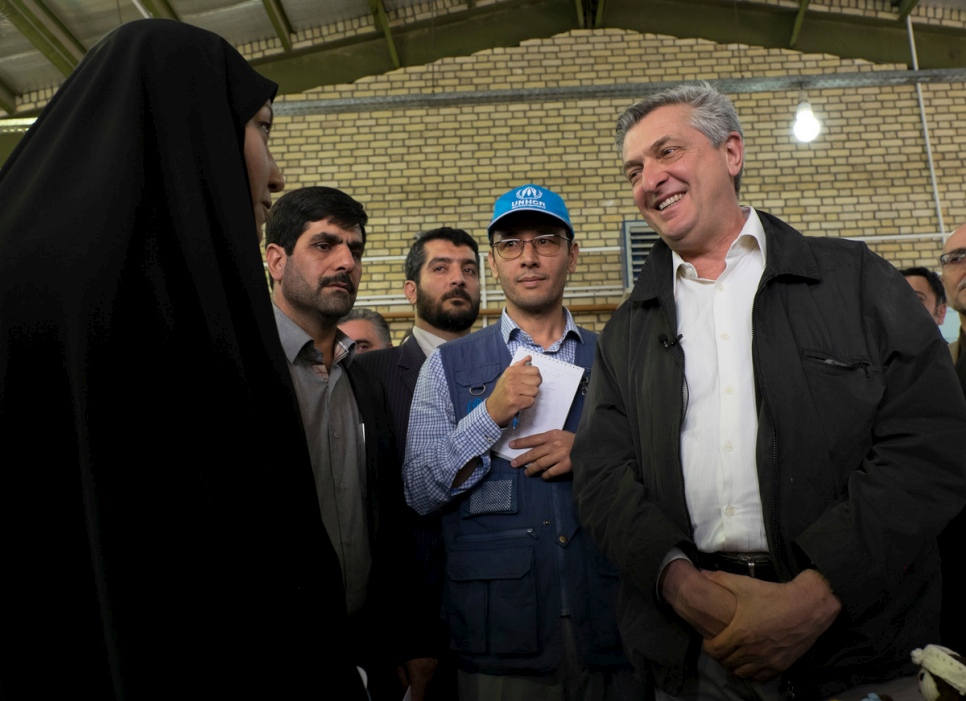Asra tells UNHCR chief she is among 730 refugees to have completed vocational courses out of population of 70,000.

UN High Commissioner for Refugees Filippo Grandi speaks with Afghan refugee Saahebeh Vafaie at the Imam Khomeini vocational training complex in Qom, Iran.
QOM, Iran, June 17 (UNHCR) – Asra’s story illustrates both the progress and the limits to progress for the enormous population of refugees in Iran today.
The 23-year-old Afghan refugee, born in Iran after her parents fled the fighting in their country, counts herself lucky. She is one of 730 to have done the vocational training course set up three years ago in Qom supported by UNHCR. That’s 700 in a refugee population of 70,000 in the city of one million people. 63,000 of them are Afghan.
She learned weaving and the making of handicrafts and is proud of her skills.
“But there’s no opportunity to work afterwards,” she said. “No opportunity for women to sell their work and for men to use their skills.”
Her brother took the auto mechanics course at the centre but now, she says, he digs wells along with her father.
The scale of the task facing Iran lies in the figures: almost one million registered refugees and at least another two million living in the country either unregistered or with Afghan passports. And many of these people have been in Iran for 30 years or more.
United Nations High Commissioner for Refugees Filippo Grandi, on his first visit to Iran, also met Mohammed Sayed, 32, who told a happier story. He has almost completed the 700-hour mechanics course. He already runs what is known as an ‘unofficial’ auto garage – refugees cannot officially own such businesses – and business is good. He employs other refugees and he says that almost half his technical skills are now due to the training course.
Would he go back to Afghanistan? “Go back? I can’t. I don’t know the situation. I don’t know the country. I was born here.”
Sakhabey is an Afghan who does want to go back. She was just one year old when her parents fled. She is now in her 20s and finishing university in English translation and says she wants to return to Aghanistan to help her people.
But she highlighted another obstacle facing refugee families.
“My father is old. I’m the only one to finish university. My sisters had to drop out because we didn’t have enough money for the tuition. Money is so important.”
The financial difficulties facing refugee families hoping their children can go to university was a constant refrain Afghans repeated to Grandi. Refugees must pay full tuition – often several thousand dollars – to study at university level in Iran.
Ali Karimi, a student preparing to go university, said the high cost and lack of university places was driving some of his friends to leave.
“I know skilful and talented people who have gone. Friends, even my cousin, decided to go to Europe,” he said. Afghans represent 21 per cent of new refugee arrivals in Europe since the beginning of 2016 and many of them lived in or went through Iran on their way north.
Grandi praised Iran for its decades-long work receiving and helping millions of refugees at great cost. He also noted that the deteriorating situation in Afghanistan made it very difficult for people to go back. The priority now, he said, is helping young refugees.
“They’re the ones in whom we need to invest more,” he said. “They’re the future. They’re often the most vulnerable. And they’re the ones with the increasing mobility who choose to move on. It’s important to anchor them until the real solution – peace in Afghanistan – is achieved.”
There are welcome developments. More than 350,000 Afghan refugee children are now in school. And in the last year, thanks to a decree from Iran’s Supreme Leader, 48,000 undocumented Afghan children were allowed to enroll for the first time in public schools.
Share on Facebook Share on Twitter